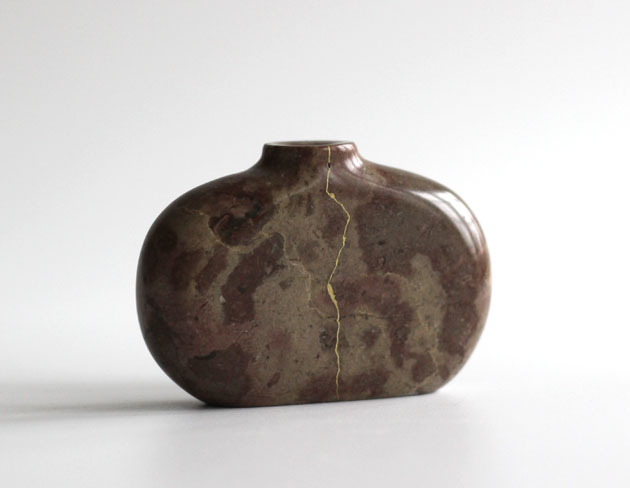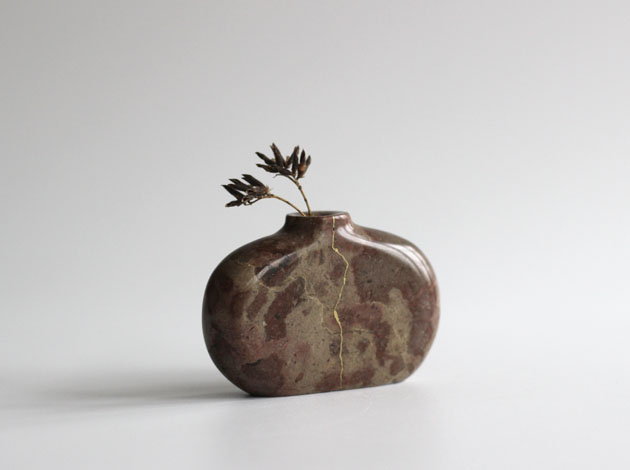So it doesn’t go to waste

Sometimes there are mishaps in the workshop. Sometimes things don’t go right and mistakes and breakages happen. Usually it is because I’m rushing or getting ahead of myself in the excitement of making. Or perhaps I don’t know a stone well enough or don’t respect it enough.
Of course it sometimes happens because of a desire to push the material as far as I dare, push my skills. There are triumphs and disasters. Always a lesson learned.
It has been my way, when things haven’t gone right, to discard the broken and start again. This is something to do with the integrity of a piece, the truth and completeness of a sculpture or carving and I think this comes from the thought of repair as a ‘cover-up’, a concealing (putting the sections back so well that no-one will notice). To me this is a cheat.
Of course this comes down to how a repair is viewed. With a slight (huge) shift of thinking I’m trying to embrace Kintsukuroi (‘golden mend’).
Kintsugi is a Japanese method of repairing broken ceramics with a special lacquer mixed with gold, silver or platinum. The philosophy behind the technique is to recognise the history of the object and to visibly incorporate the repair into the new piece instead of disguising it.
I think I do understand that if there is an object you have used and loved, that has been part of your life pattern, then the loss of it through breakage is heart-breaking, and a mended object is better than being without it, and indeed the mend tells the story of it being with you.
I’m not sure that it works so well with the making of an object – what do you think?

In this case, my vase in Eskett Light marble, I repaired partly because I didn’t want to waste this rather rare stone, and I wanted to test my feelings about putting it back together Kintsugi style.
In the light of this aesthetic principle, I’m looking with eyes seeing the beauty in the flawed and imperfect, feeling regret that something should be wasted, and also trying to accept the change (from my idea of the perfect, meticulously crafted and finished little vase).
I’m trying. Really trying.
But somehow I do just see this shimmering golden vein in the marble as a reminder of my mistake. Because I know how the break happened. I need more time with this idea of ‘golden joinery’.
PS: Mostly my vase making went well – The British marble vase collection

4 Comments
I like it. the golden line doesn’t bother me at all. I wouldn’t have known it was a repaired break if you had told us. but I get where you are coming from. I have refused to sell pieces that I think were failures even though someone wanted to buy it. we artists are our worst critics. we see the mistakes or the poor choices made, they leap out at us while no one else is even aware of them.
I think you’re probably right Ellen. Though I do like my critic self, it means I can hold my head up. Funny really it seems to go mute around housework!
I think it works really well. This is a rare material, valuable because of it is exceptionally uncommon and you’ve put in a lot of work to make something beautiful…only for it to break near the end of the process. Repairing it and being honest and transparently obvious about that, is just where craft meets art.
I love it.
Good work!
So pleased you like it – I’ve loved reading about the history and philosophy around the Japanese idea of repair and how they first created this aesthetically pleasing way of doing it. There is a story of a warrior who deliberately broke and repaired tea bowls in order to make a profit from the practice of repair, which had become a way of ornamenting ceramics for tea!